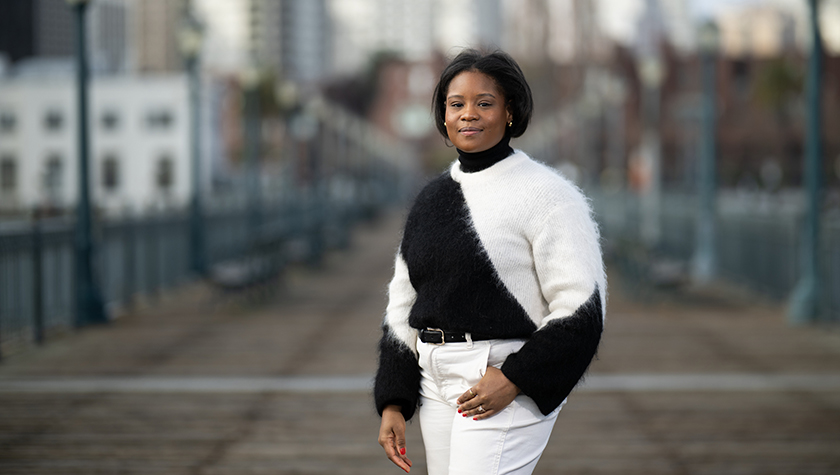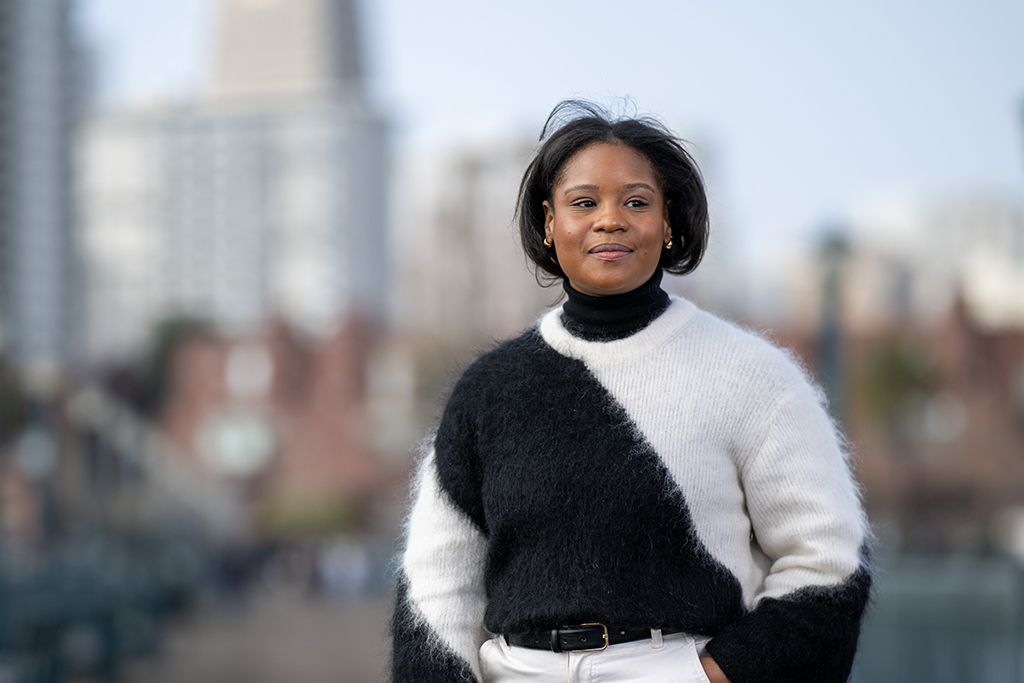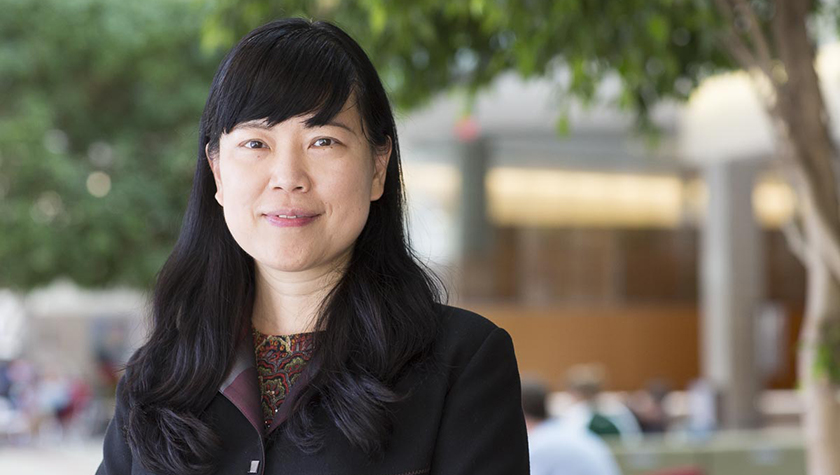
Through comics and communications, alum Kelly Montgomery bridges the gap between research and understanding, helping audiences of all backgrounds connect with science
By Katie Ginder-Vogel
How does the Epstein-Barr virus lie dormant in the body for years, only to reactivate later? In a vivid illustration, Kelly Montgomery (MS ’16) depicts the virus as a colorful chain of bead-like particles lounging in the “library” of a white blood cell — a quiet hideout where it waits for the right signal to awaken.
Through a series of illustrations, Montgomery and her collaborators reveal the virus’s journey after it receives the signal: replicating, donning its protein coat, and making its way to epithelial cells, where it spreads to new hosts like partygoers looking for their next destination.
Montgomery’s comic about the Epstein-Barr virus is just one of many ways she has brought complex scientific concepts to life. During her time as a Pharmaceutical Sciences graduate student at the University of Wisconsin–Madison School of Pharmacy, she teamed up with fellow graduate students and alumni to create comics that break down intricate topics — from the link between cancer and HIV to the mysteries of the sun’s corona and the story of Henrietta Lacks’ immortal cells.
“I want everyone to be able to see themselves as scientists.”
—Kelly Montgomery
“Visual cues are very important,” she says. “Science communication is important because someone out there just needs a picture. If it’s relatable to me, another parallel approach could help someone else. That’s why I chose this route for myself.”
Montgomery’s comics were her first sure step toward making a career out of making science accessible. Today, she’s a scientific communications manager at Abbott.
“We’re doing this for people, to help them live healthier, fuller lives,” she says.
Illustrating science, inspiring minds
As an undergraduate majoring in human biology at Michigan State University, Montgomery got interested in scientific communications because of her own challenges understanding complicated scientific concepts.
“I’ve always loved science, and that hasn’t changed. The hard part for me wasn’t the content at all but how it was communicated to me,” she says. “My desire to make science accessible was always there because of this.”
Montgomery believes anyone interested in STEM deserves to have their learning styles considered and incorporated into scientific instruction and communication. After all, there are countless people who could be excellent researchers, once they feel confident in their knowledge and skills.

Her mentor, Jerry Caldwell, at Michigan State University, introduced her to research, and she enjoyed it enough that she decided to go to graduate school at the UW–Madison School of Pharmacy and join the lab of Associate Professor of Pharmaceutical Sciences Jason Kwan.
In the process of writing a National Science Foundation grant proposal, Montgomery got to know her mentor for the proposal, Jaye Gardiner, who was a graduate student in the UW Department of Oncology and the Institute for Molecular Virology. Gardiner was also a skilled illustrator.
“We wanted to make science more accessible and engaging and had the same idea to create a comic,” Montgomery says.
They brought in another accomplished illustrator, Khoa Tran, a graduate student in cell and regenerative biology, taught themselves Adobe Illustrator, and launched JKX Comics to illustrate scientific concepts — such as the journey of the Epstein-Barr virus — for non-scientists.
“It evolved to making a legible comic, volunteering at the Wisconsin Institute for Discovery doing Saturday Science presentations and sharing our work with kids there,” Montgomery says. “We had a desire to see people engaging with STEM, understanding scientific concepts more thoroughly and effectively.”
Preparing for a career in scientific communications
After earning her master’s at the School of Pharmacy, Montgomery pursued a PhD in chemistry and chemical biology at the University of California, San Francisco, where she worked with her advisor, Jason Gestwicki, to hone her writing and presentation skills.
“We planned together to be intentional about writing and presenting,” she says. “I went to conferences, wrote grant proposals, and took on a contracting role for the Journal of the American Chemical Society.”
After a brief postdoc, she transitioned into scientific communications, starting with an internship at Genentech.
“There isn’t a set career path for people who want to pivot to science communications,” she notes. She later stayed on as a contractor, gaining experience in partnerships, public relations, and storytelling.

“What was nice about it was the ability to be creative,” Montgomery says. “I had the opportunity there to create science comics for the company and also work on day-to-day responsibilities. It was an amazing opportunity.”
Montgomery’s next role was a contract position in corporate communications at Calico Life Sciences, which provided another experience communicating science at the corporate level. Today, Montgomery manages scientific communications for Abbott full-time, working in the division that develops heart failure solutions.
“At Abbott, on the clinical regulatory side, our team generates clinical evidence to support the use of our heart failure medical devices, ensuring their safety and effectiveness for the patients they serve,” she explains.
Her role includes more project management and is more technical than her past communications roles. One of her team’s responsibilities is to develop a podium strategy as new data is released, deciding which conferences team members should attend to present their research to maximize the impact in the heart failure research and treatment community.
“I like outward-facing scientific communications, and I missed the technical aspects of grad school, digging into literature and parsing through data,” she says. “I have more of that in my professional role again.”
The power of scientific communication
Montgomery says one of the most pressing challenges in the pharmaceutical and medical device industry today is breaking through the noise. With so much information coming from different platforms and people and organizations, it’s important to determine who your audience is — who is consuming your content and what they are taking away from it. Montgomery says it’s also essential to combat misinformation, reach vulnerable populations, and present information to people in ways that connect with them.
“That’s challenging to do in science, with so many people and stakeholders involved,” she says. “How do you get the right message across and be honest and truthful and connect with people in a meaningful way?”
To make science accessible to more people, she aims to clarify scientific concepts and “distill nuances in a streamlined way.”
“I hope the work I do removes a layer of mystery from science.”
—Kelly Montgomery
“I hope the work I do removes a layer of mystery from science,” she says.
Montgomery is looking forward to continuing to learn about the clinical and regulatory side of medical technologies through her role at Abbott.
“Getting this exposure is really important for impacting patients’ lives and having a broader scope of the process from inception to completion,” she says.
Montgomery is also committed to maintaining her creativity and continues to create comics and art outside of work, with the same purpose she’s always had: to make science accessible.
“I’ve separated my creative endeavors from my professional ones intentionally, and they complement one another,” she says. “I plan to continue to grow in visual communications, so children and families have access to scientific literature that’s presented in a cute and lighthearted way. I want everyone to be able to see themselves as scientists.”
